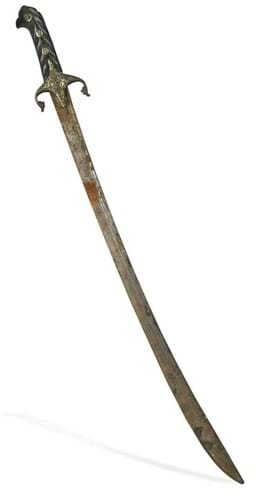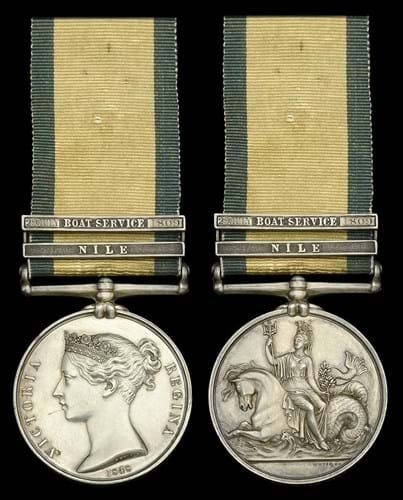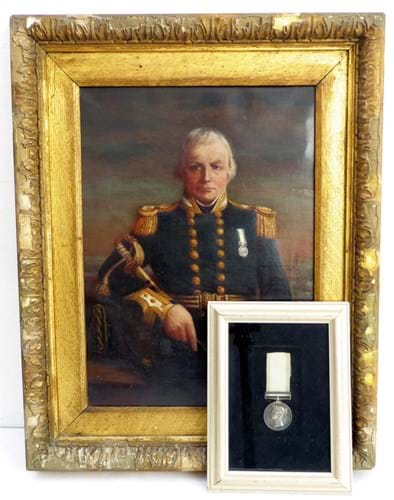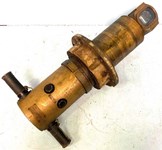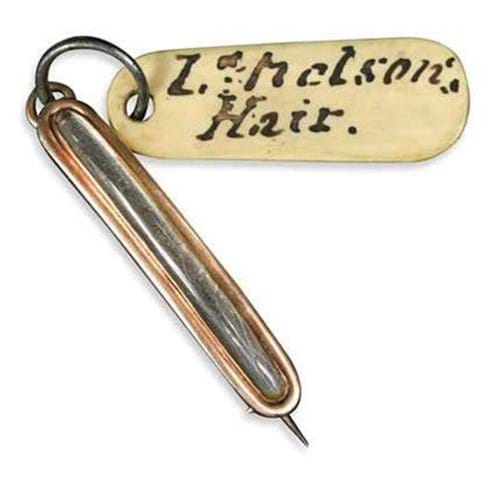
Brooch from Admiral William Waldegrave collection engraved to the reverse Lord Nelson’s Hair – £9000 at Cheffins.
William Waldegrave, 1st Baron Radstock (1753-1825), was the second son of John Waldegrave, 3rd Earl Waldegrave. On entering the RN in 1766 at the age of 13, he rose quickly through the ranks, being given his first command in HMS Zephyr in 1775. He was promoted to the rank of rear admiral in 1794 and vice admiral in 1795.
Following his involvement in the victory of the Battle of Cape St Vincent, February 14, 1797, he was awarded a baronetcy which he declined on the grounds that being the son of an earl already gave him a higher station.
Cape St Vincent was one of Nelson’s earlier experiences of battle. One of the lots on offer in the Fine Sale at Cambridge saleroom Cheffins (24.5/20/12.5% buyer’s premium) on September 22, consigned by Waldegrave family descent, was a keepsake; a brooch engraved to the reverse Lord Nelson’s Hair. It made £9000 from an EU private buyer, more than double the £2000-4000 estimate.
Also included was a Nelson commemorative snuff box, the burr walnut circular box with tortoiseshell liner, the cover inset with a silvered metal portrait medallion marked P.W.F., 7cm diameter. It took £750 online from a UK private buyer against a guide of £300-500.
Admiral Waldegrave later became governor of Newfoundland. On his return to England in 1800 he was created an Irish peer: 1st Baron Radstock, of Castletown in the Queen’s County. He married Cornelia Jacoba (1763-1839).
Sword with a story
A Turkish/Ottoman sword offered at Cheffins had a complicated backstory related to that marriage. By repute, it was provenanced to the Van Lennep and Morier families before Waldegrave ownership.
Born into a family of successful Amsterdam merchants, David George Van Lennep (1712-97) left Holland for Smyrna in Turkey in 1731, working first for the De la Fontaine and Muyssart families long associated with the Levant trade before being registered as an independent trader in December 1737 and later appointed as Dutch consul-general and president of the Dutch Levant Company. On marrying Anna Maria Leytstar in Constantinople in 1758, the Van Lenneps had 11 children.
There were two notable daughters. The first, Elizabeth Clara (1760- 1834) married Isaac Morier (1750- 1817), an Englishman and merchant who worked in his father-in-law’s firm and was later appointed first consul-general of the Levant Company at Constantinople. On the dissolution of the company in 1806, he became his Britannic Majesty’s Consul as well as an agent of the East India Company, holding both roles until his death in Constantinople in 1817 from the plague.
The second daughter was Cornelia Jacoba.
The sword, 2ft 8in (81.5cm) long overall with studded chevron-grooved wood hilt and a slightly curved 2ft 3in (68cm) blade with partial double fuller to both sides, sold within estimate at £950 to an EU private buyer.
Though lengthy, Waldegrave’s career was not glorious, it appears.
Royal Museums Greenwich (RMG) notes: “Radstock was a competent rather than especially distinguished officer, and not a notably popular one with his officers. His smooth and relatively fast rise through 28 years of active service – and considerable periods ashore – is primarily a testament to the power of aristocratic connections.”
Rare action
Admiral Waldegrave’s son, Granville George Waldegrave, 2nd Baron Radstock CB (1786-1857), joined the Royal Navy in 1798 and also rose through the ranks.
A Naval General Service Medal, estimated at £1500-2500 on September 21, was named to Hon. G.G.Waldegrave. Capt. R.N. It sold to a UK private buyer for £26,000.
He became a captain in 1807, rear admiral in 1841, vice admiral of the White in 1853 and the Red in 1855. From 1831-37, he was a naval aide-de-camp to King William IV and to Queen Victoria from 1837-41.
According to RMG: “George Waldegrave was placed on the books of his father’s ship Courageux in 1794, though he first went to sea under him in the Agincourt in 1798, when his father was governor of Newfoundland.
“Eight years later, early in 1807, he became a captain and commanded the 32-gun frigate Thames in the Mediterranean until 1811. He then took over the 38-gun Volontaire until 1815, in the Mediterranean and on the north coast of Spain. Throughout these commissions he was highly active, attacking coastal positions and cutting out enemy shipping.”
As well as the noteworthy recipient and market freshness, this medal had the bonus of displaying a single clasp which counts as one of the rarest: Amanthea, 25 July 1810.
As previously noted in ATG, given the abundance of NGSMs around (20,933 were awarded retrospectively in 1848 for RN service from 1793- 1840, with 15,577 showing a single clasp), the number and type of clasps awarded for a single action becomes crucial to value.
The Admiralty authorised 231 clasps, though in 10 cases all potential claimants had died prior to the authorisation of the medal, with the result that those clasps were never issued.
For the action against gunboats and the capture and destruction of a number of transports at Amantea, southern Italy, involving HMS Thames, just 23 were issued.
Unique combination
A similar hammer price, £28,000, was paid for a NGSM sold on top estimate at Noonans (24% buyer’s premium) on July 27.
It was awarded to Rear-Admiral John Harper, CB, Royal Navy, who was made a Knight of the Order of Leopold by the Emperor of Austria for his distinguished conduct at the successful sieges of Cattaro and Ragusa in January 1814.
It featured clasps for Nile and 29 July Boat Service 1809 (a unique combination).
Just 11 clasps were issued for the latter, with examples being held by the National Maritime Museum, the Royal Naval Museum, the Royal Marines Museum, and in the Patiala Collection (Sheesh Mahal Museum, India).
Lt Harper was the only officer promoted for this Boat Service action.
Fifty-five out of the total 231 NGSM clasps sanctioned were given for such small-scale ‘boat actions’.
Transatlantic struggle
NGSMs given for the War of 1812 between the UK and the US have a strong collector following from both countries.
An example awarded to Assistant Surgeon Robert Dobie with a single clasp for the action on the Potomac River on August 17, 1814, was offered at Kent saleroom C&T (22% buyer’s premium) on July 26-28 with a guide of £3000-5000 but sold for £14,000.
A total of 104 clasps were issued for this action, of which 35 were issued to the crew of frigate HMS Seahorse (six officers and 29 ratings), including Dobie.
Round the world voyage
Commander Charles Brown (1789-1869), the Master of HMS Warspite, was the first to circumnavigate the globe in a British ship of the line.
When news reached London that the Warspite had arrived safely in Portsmouth on July 28, 1827, the High Admiral, later William IV, came down from London to give his congratulations.
Brown’s Naval General Service Medal with Guadeloupe clasp sold for £4400 at Gloucestershire auction house Tayler & Fletcher (21% buyer’s premium) on June 16 against an estimate £1500-2000. It was offered with his portrait in oil by an unknown artist.
The clasp relates to his service on the Lorna schooner at the taking of Guadeloupe in 1810, where he was frequently employed in her boats in the capture of enemy vessels.
Guadeloupe is actually one of the more common NGSM clasp examples at 484 awards.



